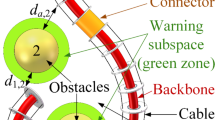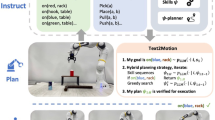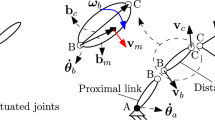Abstract
In this paper, we develop self-assembling robot systems composed of active modular robots and passive bars. The target structure is modeled as a dynamic graph. We present two provably correct algorithms for creating the structure. A decentralized optimal algorithm for the navigation of multiple modular robots on a partial truss structure is used to guide the robots to their location on the target structure. A decentralized algorithm for scheduling the transportation and placement of truss elements is used to coordinate the creation of the target structure. Both algorithms rely on locally optimal matching. The truss self-assembly algorithm has quadratic competitive ratio for static as well as dynamic graph representation. We show simulation results and results for experiments with two 3DOF robots and passive bars that can create and control a 6DOF manipulation.
Similar content being viewed by others
References
Almonacid, M., Saltarén, R. J., Aracil, R., & Reinoso, O. (2003). Motion planning of a climbing parallel robot. IEEE Transactions on Robotics and Automation, 19(3), 485–489.
Amano, H., Osuka, K., & Tarn, T. J. (2001). Development of vertically moving robot with gripping handrails for fire fighting. In Proceedings of the 2001 IEEE/RSJ international conference on intelligent robots and systems, Maui, HI, USA (pp. 661–667).
Asadpour, M., Ashtiani, M., Sproewitz, A., & Ijspeert, A. (2009). Graph signature for self-reconfiguration planning of modules with symmetry. In IEEE/RSJ international conference on intelligent robots and systems, St. Louis, USA (pp. 5295–5300).
Ayanian, N., White, P., Halasz, A., Yim, M., & Kumar, V. (2008). Stochastic control for self-assembly of xbots. In Proceedings of ASME international design engineering technical conferences & computers and information in engineering conference, New York, NY, USA.
Butler, Z., & Rus, D. (2003). Distributed planning and control for modular robots with unit-compressible modules. The International Journal of Robotics Research, 22(9), 699–715.
Castano, A., Shen, W., & Will, P. (2000). CONRO: towards deployable robots with inter-robots metamorphic capabilities. Autonomous Robots, 8(3), 309–324.
Chiang, C. J., & Chirikjian, G. (2001). Modular robot motion planning using similarity metrics. Autonomous Robots, 10(1), 91–106.
Chirikjian, G., Pamecha, A., & Ebert-Uphoff, I. (1996). Evaluating efficiency of self-reconfiguration in a class of modular robots. Journal of Robotic Systems, 13(5), 717–338.
Choi, H., Han, C., Lee, K., & Lee, S. (2005). Development of hybrid robot for construction works with pneumatic actuator. Automation in Construction, 14(4), 452–459.
Christensen, A.L., O’Grady, R., & Dorigo, M. (2008). Morphology control in a multirobot system. IEEE Robotics & Automation Magazine, 14(4), 18–25.
Detweiler, C., Vona, M., Yoon, Y., Yun, S., & Rus, D. (2007). Self-assembling mobile linkages. IEEE Robotics & Automation Magazine, 14(4), 45–55.
Duff, D., Yim, M., & Roufas, K. (2001). Evolution of polybot: a modular reconfigurable robot. In Proceedings of the harmonic drive international symposium, Nagano, Japan.
Edmonds, J., & Karp, R. M. (1972). Theoretical improvements in algorithmic efficiency for network flow problems. Journal of the ACM, 19(2), 248–264.
Fahlman, S. (1973). A planning system for robot construction tasks (Tech. rep.). Massachusetts Institute of Technology, Cambridge, MA, USA.
Fichter, E. (1986). A Stewart-platform based manipulator: general theory and practical construction. The International Journal of Robotics Research, 5(2), 157–182.
Gilbin, K., & Rus, D. (2010). Modular robot systems. IEEE Robotics & Automation Magazine, 17, 38–55.
Hamacher, H., & Tjandra, S. (2001). Mathematical modeling of evacuation problems: state of the art. Pedestrian and evacuation dynamics (Tech. rep.). Institut Techno- und Wirtschaftsmathematik.
Hamlin, G., & Sanderson, A. (1997). Tetrobot: a modular approach to parallel robotics. IEEE Robotics & Automation Magazine, 4(1), 42–50.
Hou, F., Ranasinghe, N., Salemi, B., & Shen, W. M. (2008). Wheeled locomotion for payload carrying with modular robot. In IEEE/RSJ international conference on intelligent robots and systems, Nice, France (pp. 1331–1337).
Jorgensen, M., Ostergaard, E., & Lund, H. (2004). Modular atron: Modules for a self-reconfigurable robot. In IEEE/RSJ international conference on intelligent robots and systems, Sendai, Japan (pp. 2068–2073).
Kalayanasundaram, B., & Pruhs, K. (1993). Online weighted matching. Journal of Algorithms, 14(3), 478–488.
Kalyanasundaram, B., & Pruhs, K. (1995). The online transportation problem. In ESA ’95: proceedings of the third Annual European Symposium on Algorithms (pp. 484–493). London: Springer.
Kasper Støy (2005). The ATRON self-reconfigurable robot: challenges and future directions. In Workshop on self-reconfigurable robotics at the robotics science and systems conference.
Khuller, S., Mitchell, S., & Vazirani, V (1994). On-line algorithms for weighted bipartite matching and stable marriages. Theory and Computational Science, 127(2), 255–267.
Klavins, E., Ghrist, R., & Lipsky, D. (2006). A grammatical approach to self-organizing robotic systems. IEEE Transactions on Automatic Control, 51(6), 949–962.
Kotay, K., & Rus, D. (2005). Efficient locomotion gait for a self-reconfiguring robot. In Proceedings of the IEEE international conference on robotics and automation, Barcelona, Spain (pp. 2963–2969).
Kotay, K., Rus, D., Vona, M., & McGray, C. (1998). The self-reconfiguring robotic molecule. In IEEE International Conference on Robotics and Automation, Leuven, Belgium (pp. 424–431).
Kotay, K. D., & Rus, D. L. (1996). Navigating 3d steel web structures with an inchworm robot. In Proceedings of the IEEE international conference on intelligent robots and systems.
Kuhn, H. (1955). The Hungarian method for the assignment problem. Naval Research Logistics Quarterly, 2(1–2), 83–97.
Kutzer, M., Moses, M., Brown, C., Armand, M., Scheidt, D., & Chirikjian, G. (2010). Design of a new independently-mobile reconfigurable modular robot. In International conference on robotics and automation, Anchorage, Alaska, USA (pp. 2758–2764).
Lee, S., Lee, K., Lee, S., Kim, J., & Han, C. (2007). Human-robot cooperation control for installing heavy construction materials. Autonomous Robots, 22(3), 305–319.
Lyder, A., Garcia, R., & Støy, K. (2008). Mechanical design of Odin, an extendable heterogeneous deformable modular robot. In IEEE/RSJ international conference on intelligent robots and systems, Nice, France (pp. 883–888).
Matthey, L., Berman, S., & Kumar, V. (2009). Stochastic strategies for a swarm robotic assembly system. In Proceedings of IEEE international conference on robotics and automation, Kobe, Japan (pp. 1953–1958). New York: IEEE Press.
Meyerson, A., Nanavati, A., & Poplawski, L. (2006). Randomized online algorithms for minimum metric bipartite matching. In ACM-SIAM symposium on discrete algorithms, Miami, Florida, USA (pp. 954–959).
Moses, M., Yamaguchi, H., & Chirikjian, G. (2009). Towards cyclic fabrication systems for modular robotics. In Proceedings of robotics: science and systems, Seattle, USA.
Murata, S., Kurokawa, H., Yoshida, E., Tomita, K., & Kokaji, S. (1998). A 3-d self-reconfigurable structure. In Proceedings of the 1998 IEEE international conference on robotics and automation, Leuven, Belgium (pp. 432–439).
Murata, S., Kakomura, K., & Kurokawa, H. (2008). Toward a scalable modular robotic system. IEEE Robotics & Automation Magazine, 14(4), 56–63.
Nechyba, M., & Xu, Y. (1995). Human-robot cooperation in space: SM2 for new space station structure. IEEE Robotics & Automation Magazine, 2(4), 4–11.
Pamecha, A., Chiang, C., Stein, D., & Chirikjian, G. (1996). Design and implementation of metamorphic robots. In The 1996 ASME design engineering technical conference and computers in engineering conference, Irvine, CA.
Pamecha, A., Ebert-Uphoff, I., & Chirikjian, G. (1997). A useful metric for modular robot motion planning. IEEE Transactions on Robotics and Automation, 13(4), 531–545.
Park, M., Chitta, S., Teichman, A., & Yim, M. (2008). Automatic configuration methods in modular robots. International Journal of Robotics Research, 27(3–4), 403–421.
Parker, C., Zhang, H., & Kube, R. (2003). Blind bulldozing: multiple robot nest construction. In IEEE/RSJ international conference on intelligent robots and systems, Las Vegas, Nevada, USA (pp. 2010–2015).
Phillips, J., & Agarwal, P. (2006). On bipartite matching under the rms distance. In 18th Canadian conference on computational geometry, Kingston, Ontario.
Ripin, Z., Soon, T., Abdullah, A., & Samad, Z. (2000). Development of a low-cost modular pole climbing robot. In TENCON 2000. Proceedings, Kula Lumpur, Malaysia (Vol. 1, pp. 196–200).
Rus, D., & Vona, M. (2001). Crystalline robots: Self-reconfiguration with compressible unit modules. Autonomous Robots, 10(1), 107–124.
Salemi, B., Moll, M., & Shen, W. M. (2006). SUPERBOT: a deployable, multi-functional, and modular self-reconfigurable robotic system. In IEEE/RSJ international conference on intelligent robots and systems, Beijing, China (pp. 3636–3641).
Schultz, U., Christensen, D., & Stoy, K. (2007). A domain-specific language for programming self-reconfigurable robots. In GPCE’07 workshop on automatic program generation for embedded systems, Salzburg, Austria (pp. 28–60).
Skaff, S., Staritz, P., & Whittaker, W. (2001). Skyworker: Robotics for space assembly, inspection and maintenance. In Proceedings of the thirteenth space studies institute conference on space manufacturing (pp. 104–108).
Sproewitz, A., Billard, A., Dillenbourg, P., & Ijspeert, A. J. (2009). Roombots-Mechanical design of Self-Reconfiguring modular robots for adaptive furniture. In 2009 IEEE international conference on robotics and automation, Kobe, Japan (pp. 4259–4264).
Stroupe, A., Huntsberger, T., Okon, A., Aghazarian, H., & Robinson, M. (2005). Behavior-based multi-robot collaboration for autonomous construction tasks. In IEEE/RSJ international conference on intelligent robots and systems, Alberta, Canada (pp. 1495–1500).
Unsal, C., Kiliccote, H., & Khosla, P. (2001). A modular self-reconfigurable bipartite robotic system: implementation and motion planning. Autonomous Robots, 10(1), 23–40.
Vaidya, P. (1988). Geometry helps in matching. In STOC ’88: proceedings of the twentieth annual ACM symposium on theory of computing, Chicago, IL, United States (pp. 422–425).
Werfel, J. (2001). Anthills built to order: automating construction with artificial swarms. Master’s thesis, Electrical Engineering and Computer Science, Massachusetts Institute of Technology, Cambridge, MA, USA.
Werfel, J., & Nagpal, R. (2008). Three-dimensional construction with mobile robots and modular blocks. The International Journal of Robotics Research, 3–4(27), 463–479.
White, P. J., Thorne, C. E., & Yim, M. (2009). Right Angle Tetrahedron Chain Externally-actuated Testbed (RATCHET): a shape changing system. In International design engineering technical conferences & computers and information in engineering conference, San Diego, CA, USA.
Williams, R., & Mayhew, J. (1997). Cartesian control of VGT manipulators applied to DOE hardware. In Proceedings of the fifth national conference on applied mechanisms and robotics, Cincinnati, OH.
Yamada, H., & Muto, T. (2007). Construction tele-robotic system with virtual reality (cg presentation of virtual robot and task object using stereo vision system). Control and Intelligent Systems, 35(3), 195–201.
Yim, M., Shen, W., Salemi, B., Rus, D., Moll, M., Lipson, H., Klavins, E., & Chirickjian, G. (2007). Modular self-reconfigurable robot systems. IEEE Robotics & Automation Magazine, 14(1), 43–52.
Yoon, Y. (2006). Modular robots for making and climbing 3-d trusses. Master’s thesis, Computer Science and Artificial Intelligence Laboratory, MIT, Cambridge, MA, USA.
Yun, S., & Rus, D. (2007). Optimal distributed planning of multi-robot placement on a 3d truss. In IEEE/RSJ international conference on intelligent robots and systems, San Diego, CA, USA (pp. 1365–1370).
Yun, S., & Rus, D. (2008). Self assembly of modular manipulators with active and passive modules. In Proc. of IEEE/RSJ IEEE international conference on robotics and automation, Pasadena, CA (pp. 1477–1482) (to appear).
Yun, S., Hjelle, D., Lipson, H., & Rus, D. (2009). Planning the reconfiguration of grounded truss structures with truss climbing robots that carry truss elements. In IEEE/RSJ IEEE international conference on robotics and automation, Kobe, Japan (pp. 1327–1333).
Zhao, D., Xia, Y., Yamada, H., & Muto, T. (2003). Control method for realistic motions in a construction tele-robotic system with a 3-dof parallel mechanism. Journal of Robotics and Mechatronics, 15(4), 361–368.
Zykov, V., Mytilinaios, E., Desnoyer, M., & Lipson, H. (2007). Evolved and designed self-reproducing modular robotics. IEEE Transactions on Robotics, 23(2), 308–319.
Author information
Authors and Affiliations
Corresponding author
Electronic Supplementary Material
Below are the links to the electronic supplementary material.
(AVI 5.58 MB)
(WMV 1.02 MB)
(MP4 7.94 MB)
Rights and permissions
About this article
Cite this article
Yun, Sk., Rus, D. Optimal self assembly of modular manipulators with active and passive modules. Auton Robot 31, 183–207 (2011). https://doi.org/10.1007/s10514-011-9236-1
Received:
Accepted:
Published:
Issue Date:
DOI: https://doi.org/10.1007/s10514-011-9236-1




